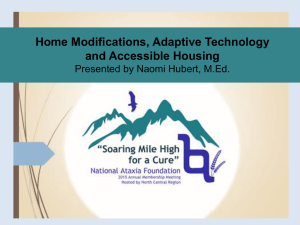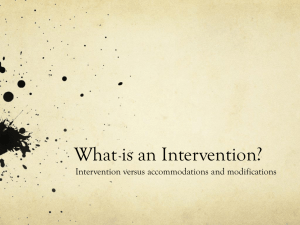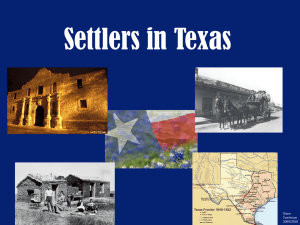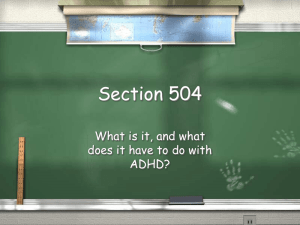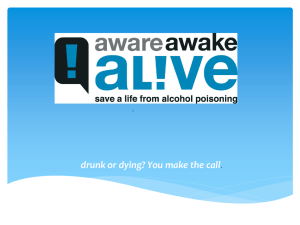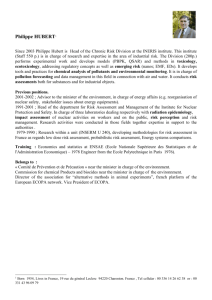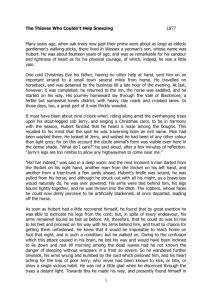Home Modification and Assistive Technology in the Home
advertisement
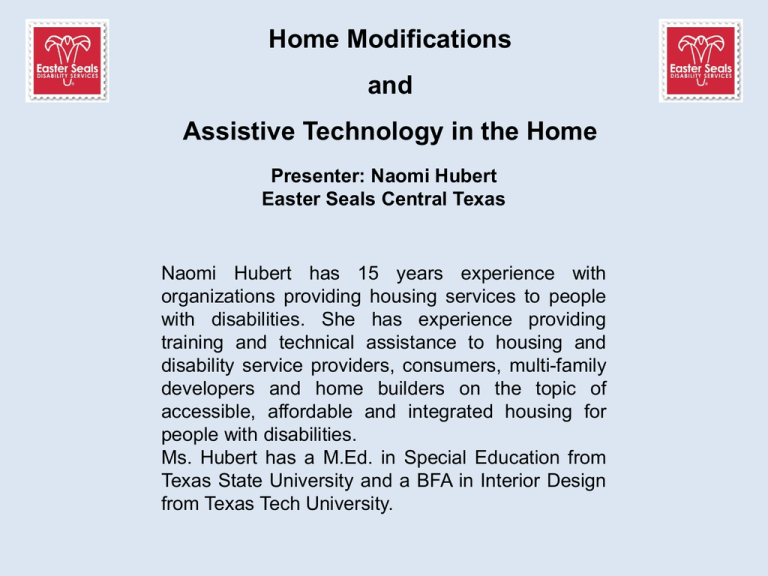
Home Modifications and Assistive Technology in the Home Presenter: Naomi Hubert Easter Seals Central Texas Naomi Hubert has 15 years experience with organizations providing housing services to people with disabilities. She has experience providing training and technical assistance to housing and disability service providers, consumers, multi-family developers and home builders on the topic of accessible, affordable and integrated housing for people with disabilities. Ms. Hubert has a M.Ed. in Special Education from Texas State University and a BFA in Interior Design from Texas Tech University. 1.How to Complete a Home Assessment 2.Simple to Complex Home Mods 3.Using Technology to Make Your Home More Useable 4.Advocating for Home Mods and AT Home Modifications The term ‘home modifications’ encompasses a broad range of alterations made to one’s home in order to create a more usable and comfortable environment in which to carry out daily activities. Home Assessments Individual needs vary greatly, so it is important to design an assessment process which will result in individualized modifications What do you need? One Size does not fit all Federal accessibility design requirements are meant to meet the needs of the general public and rarely address individual needs Checklists can be helpful but only when used in a face-to-face, room-to-room evaluation Long distance evaluations do not work Someone completing a needs assessment from his/her office will probably not address individual needs Solutions will be individual because each person with a disability is an individual Different people facing a similar obstacle may require a different solution due to their specific needs HOME MODICIFCATIONS: Simple to Complex Single Lever Door Handle Standard Door Hinge Door width 32” Actual opening is approx. 30” door width is 32” actual opening is approx. 31 ½” Off Set Hinge Shower Hose Fold Down Grab Bars “Designer” Grab Bars Bathtub Lift Walk-In Tub Single Lever Faucets Pull Out Shelves ‘Reacher’ Pull Down Shelves Flipper Doors EZ Pocket Doors Other Considerations 1.Flooring 2.Surface of Walls and Doors 3.Lighting 4.Furniture Placement 5.Height, Location and Type of Outlets, Switches & Environmental Controls 6.Exterior Spaces BATHROOM MODIFICATIONS shower closet storage BEFORE storage shower storage AFTER Assistive Technology A term used to describe all of the tools, products, and devices, from the simplest to the most complex, that can make a particular function easier or possible to perform. Intercom Systems Hard-wired Battery operated Linked with other systems Keyless Entry Automatic Door Openers Hearing Aids for people who are deaf or hard of hearing Vision Aids for people with visual impairments Magnifiers Personal Digital Assistant/PDA Scanner/Reader Communication Boards Augmentative & Alternative Communication Assistance Using Computers On Screen Key Board Eye Tracker Systems Mouse replacement device that allows the user to place the mouse pointer anywhere on the screen by simply looking at the desired location. E C U Environmental Control Units: enable people with disabilities to control their personal environment including telephones, televisions and other infrared devices, lights, appliances, electric beds and personal computers. Environmental Control Units/ECU ADVOCATING FOR HOME MODIFICATIONS Can I get a grab bar installed in my bathroom? Accessibility Requirements ADA…Fair Housing…Section 504… What do they mean??? The Fair Housing Act Establishes design and construction requirements for multifamily housing of four or more units built for first occupancy after March 13, 1991 (privately funded) Landlords/Owners cannot refuse to make reasonable accommodations when such accommodations may be necessary to afford a person with a disability equal opportunity to use and enjoy a dwelling Landlords/Owners are not required to pay for the modifications but can request that the tenant restore the unit to it’s original condition Section 504 of the Rehabilitation Act of 1973 Access requirements apply to new construction of federally subsidized multi-family housing having 5 or more units constructed after July 11, 1988 A percentage of units must be made readily accessible and not merely adaptable for people with disabilities Request for reasonable accommodations cannot be refused and are completed at the owner’s/landlord’s expense Americans with Disabilities Act Civil right law guaranteeing equal opportunity for individuals with disabilities in employment, state and local government services, public accommodations, transportation and telecommunications People with disabilities must have equal opportunity in places of public accommodation, both in terms of physical access and in the enjoyment of services Basic Access Legislation Texas Statewide Basic Access Law Applies to single family homes constructed with public funds Basic Access requirements are very similar to the Fair Housing Design Guidelines Funding for Home Modifications Texas Department of Housing and Community Affairs 2010 Amy Young Barrier Removal Program www.tdhca.state.tx.us Easter Seals Community and Housing Services CHAMP http://centraltx.easterseals.com Other Resources City and/or County Home Repair Programs Texas Department of Assistive and Rehabilitative Services www.dars.state.tx.us Texas Department of Aging and Disability Services www.dads.state.tx.us Department of Veterans Affairs www.va.gov US Department of Agriculture www.usda.gov Urban League, Community Action Agencies, Services for the Elderly Texas Technology Access Program (device loan program) Easter Seals Central Texas Community and Housing Services 1611 Headway Circle, Bldg 2 Austin, Texas 78754 512-615-6830 Kelly Garcia kgarcia@eastersealstx.com Naomi Hubert naomishubert@gmail.com Jackie Conerly jconerly@eastersealstx.com
